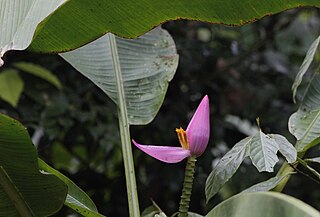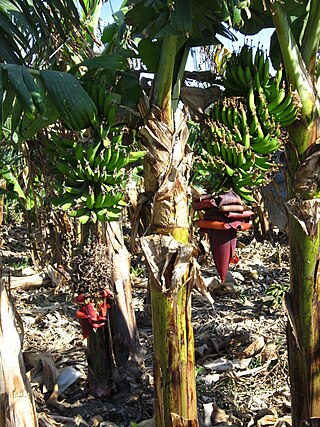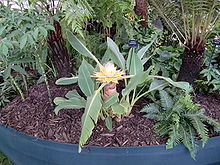
Musaceae is a family of flowering plants composed of three genera with about 91 known species, placed in the order Zingiberales. The family is native to the tropics of Africa and Asia. The plants have a large herbaceous growth habit with leaves with overlapping basal sheaths that form a pseudostem making some members appear to be woody trees. In most treatments, the family has three genera, Musa, Musella and Ensete. Cultivated bananas are commercially important members of the family, and many others are grown as ornamental plants.

Aralia, or spikenard, is a genus of the family Araliaceae, consisting of 68 accepted species of deciduous or evergreen trees, shrubs, and rhizomatous herbaceous perennials. The genus is native to Asia and the Americas, with most species occurring in mountain woodlands. Aralia plants vary in size, with some herbaceous species only reaching 50 centimetres (20 in) tall, while some are trees growing to 20 metres (66 ft) tall.

Daphne is a genus of between 70 and 95 species of deciduous and evergreen shrubs in the family Thymelaeaceae, native to Asia, Europe and north Africa. They are noted for their scented flowers and often brightly coloured berries. Two species are used to make paper. Many species are grown in gardens as ornamental plants; the smaller species are often used in rock gardens. All parts of daphnes are poisonous, especially the berries.
Michelia is a historical genus of flowering plants belonging to the family Magnoliaceae. The genus included about 50 species of evergreen trees and shrubs, native to tropical and subtropical south and southeast Asia (Indomalaya), including southern China. Today it is regarded as a synonym of Magnolia.

Elaeagnus, silverberry or oleaster, is a genus of about 50–70 species of flowering plants in the family Elaeagnaceae.

Androsace, commonly known as rock jasmine, is a genus of flowering plants in the family Primulaceae, second only to Primula in the number of species. It is predominantly Arctic–alpine, with many species in the Himalayas, the mountains of central Asia, the Caucasus, and the southern and central European mountain systems, particularly the Alps and the Pyrenees.

Stewartia is a genus of 8-20 species of flowering plants in the family Theaceae, related to Camellia. Most of the species are native to eastern Asia in China, Japan, Korea, Laos, Myanmar, Thailand, and Vietnam, with two in southeast North America, from Virginia and Kentucky south to Florida and Louisiana.

Podophyllum is a genus of flowering plant in the family Berberidaceae, native from Afghanistan to China, and from southeast Canada to the central and eastern United States. The genus was first described by Carl Linnaeus in 1753.

Musa is one of three genera in the family Musaceae. The genus includes 83 species of flowering plants producing edible bananas and plantains. Though they grow as high as trees, banana and plantain plants are not woody and their apparent "stem" is made up of the bases of the huge leaf stalks. Thus, they are technically gigantic herbaceous plants. Musa species are used as food plants by the larvae of some Lepidoptera species, including the giant leopard moth and other Hypercompe species, including H. albescens, H. eridanus, and H. icasia.

Musa basjoo, known variously as Japanese banana, Japanese fibre banana or hardy banana, is a species of flowering plant belonging to the banana family Musaceae. It was previously thought to have originated in the Ryukyu islands of southern Japan, from where it was first described in cultivation, but is now known to have originated in subtropical southern China, where it is also widely cultivated, with wild populations found in Sichuan province. Its specific name is derived from its Japanese common name, bashō (芭蕉).

Musa sikkimensis, also called Darjeeling banana, is a species of the genus Musa. It is one of the highest altitude banana species and is found in Bhutan and India.

Musa ornata, the flowering banana, is one of more than 50 species of banana in the genus Musa of the family Musaceae. Most of these species are large tropical evergreen perennials, mainly from lowland areas with high temperature and humidity. Musa ornata originated in southeast Asia, and is cultivated for its commercial and ornamental value. The fruit is attractive but tends to be inedible.

Fe'i bananas are cultivated plants in the genus Musa, used mainly for their fruit. Unlike most other cultivated bananas they are diploids of the AA-type. They are very distinct in appearance and origin from the majority of bananas and plantains currently grown. Found mainly in the islands of the Pacific, particularly French Polynesia, Fe'i bananas have skins which are brilliant orange to red in colour with yellow or orange flesh inside. They are usually eaten cooked and have been an important food for Pacific Islanders, moving with them as they migrated across the ocean. Most are high in beta-carotene.

Musa coccinea, commonly known as scarlet banana or red-flowering banana, is a species of flowering plant in the banana and plantain family Musaceae, native to tropical China and Vietnam. It is a bat-pollinated evergreen perennial, placed in section Callimusa, having a diploid chromosome number of 2n = 20.

Musa × paradisiaca is the accepted name for the hybrid between Musa acuminata and Musa balbisiana. Most cultivated bananas and plantains are triploid cultivars either of this hybrid or of M. acuminata alone. Linnaeus originally used the name M. paradisiaca only for plantains or cooking bananas, but the modern usage includes hybrid cultivars used both for cooking and as dessert bananas. Linnaeus's name for dessert bananas, Musa sapientum, is thus a synonym of Musa × paradisiaca.
Musa monticola, also known as the Kinabalu mountain banana, is a species of wild banana, native to Sabah on the island of Borneo. It is placed in section Callimusa, having a diploid chromosome number of 2n = 20.
Hemiboea is a genus of flowering plants belonging to the family Gesneriaceae.

Rubus xanthocarpus is a species of flowering plant in the raspberry genus Rubus, family Rosaceae. It is native to central and southern China, and has naturalized in Poland and the former Czechoslovakia. It is available from commercial suppliers. The orange-yellow fruit are edible, taste similar to raspberries, and can be eaten raw or made into preserves or wine.
Magnolia fulva is a species of flowering plant in the family Magnoliaceae, native to south-central China and Vietnam. It was first described, as Michelia fulva, in 1987.

















